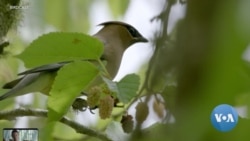ວັນທີ 14 ຕຸລາ ແມ່ນວັນຍົກຍ້າຍຖິ່ນຖານໂລກຂອງນົກ ຢູ່ໃນຊີກໂລກໃຕ້. ເພື່ອ ຄາດຄະເນການເຄື່ອນຍ້າຍຂອງນົກໃຫ້ໄດ້ດີກວ່າເກົ່າ ນັກວິທະຍາສາດກໍາລັງ ໃຊ້ເຄື່ອງຈັກໃນການຮຽນຮູ້ ແລະເຣດາລຸ້ນໃໝ່. ຜົນໄດ້ຮັບຂອງອຸປະກອນ ເບີດແຄສ ("BirdCasts") ບໍ່ພຽງແຕ່ເຮັດໃຫ້ການເບິ່ງນົກມີຄວາມມ່ວນຊື່ນເທົ່ານັ້ນ ມັນຍັງສະເຫນີວິທີການໃຫມ່ເພື່ອຊ່ວຍນົກທີ່ມີຄວາມສ່ຽງຕໍ່ການສູນພັນ ອີກດ້ວຍ. Shelley Schlender ມີລາຍງານເລື່ອງນີ້ມາໃຫ້ພວກເຮົາຈາກເຂດພູ ຣັອກກີ ຫລື Rocky Mountain ໃນລັດໂຄໂລຣາໂດ ຊຶ່ງບົວສະຫວັນ ຈະນໍາມາ ສະເໜີທ່ານໃນອັນດັບຕໍ່ໄປ.
ນົກຫຼາຍພັນລ້ານໂຕໄດ້ບິນໄປຫຼາຍພັນກິໂລແມັດ ໃນລະຫວ່າງການເຄື່ອນຍ້າຍ. ຜູ້ເອົາເຄື່ອງໝາຍໃສ່ນົກເຊັ່ນ ສຕີບ ເບີຣີຊຽສ (Steve Bouricius) ທໍາການ ສຶກສາຄົ້ນຄວ້າກ່ຽວກັບນົກເທື່ອລະໂຕໄປ. . . .
ທ່ານ ສຕີບ ເບີຣີຊຽສ (Steve Bouricius), ນັກຊຽວຊານດ້ານເຄື່ອງໝາຍໃສ່ນົກ ເຜີ້ງ ຫລື Hummingbird ກ່າວວ່າ:
"ລາວໄດ້ຢູ່ໃນໄລຍະທີ່ມີການເຄື່ອນຍ້າຍຂອງລາວແລ້ວ."
ແຕ່ເທັກໂນໂລຈີ ໃຫມ່ທັງຫຼາຍສາມາດຕິດຕາມເບິ່ງນົກເປັນລ້ານໆໂຕໃນເວລາດຽວກັນ.
ຢູ່ທີ່ມະຫາວິທະຍາໄລລັດໂຄໂລຣາໂດນັ້ນ ຜູ້ຊ່ວຍອາຈານສອນຊີວະສາດ ຄາຍລ໌ ຮໍຕັນ (Kyle Horton) ເຮັດວຽກກ່ຽວກັບອຸປະກອນເບີດແຄສ (BirdCast), ເຊິ່ງ ສ້າງແຜນທີ່ການເຄື່ອນຍ້າຍຂອງນົກແບບນີ້ ທີ່ສະແດງໃຫ້ເຫັນນົກເກືອບຮອດ 800 ລ້ານໂຕ ຢູ່ທົ່ວສະຫະລັດພາຍໃນເວລາພຽງຄືນດຽວ.
ເຣດາພະຍາກອນສະພາບອາກາດສະຫນອງຂໍ້ມູນໃຫ້ແກ່ BirdCast . . . .ແບບມະຫັດສະຈັນ. ນັກວິທະຍາສາດດ້ານດິນຟ້າອາກາດເຝົ້າເບິ່ງເມັດຝົນຕົກ ແລະການກັ່ນຕອງເອົາສັດທີ່ມີປີກອອກມາ.
ທ່ານຮໍຕັນ, ຈາກມະຫາວິທະຍາໄລລັດໂຄໂລຣາໂດກ່າວວ່າ:
"ໂດຍພື້ນຖານແລ້ວພວກເຮົາເຮັດໃນທາງກົງກັນຂ້າມກັບສິ່ງທີ່ນັກອຸຕຸນິຍົມເຮັດ. ດັ່ງນັ້ນ, ພວກເຮົາເອົານໍ້າຝົນອອກ ແລະຮັກສາຊີວະວິທະຍາໄວ້."
ເຣດາຕາມປົກກະຕິແລ້ວ ບໍ່ສາມາດບອກໃຫ້ຮູ້ວ່າ ເປັນຝູງນົກຮ້ອງ ຫລື ຝູງແມງໄມ້ ກັນແທ້. ອຸປະກອນ BirdCast ຊ່ວຍໄຈ້ແຍກກ່ຽວກັບທັງສອງຢ່າງນີ້ໄດ້ ໂດຍການເພີ່ມຂໍ້ມູນຈາກບັນທຶກຂອງເຄື່ອງໝາຍທີ່ເອົາຕິດໃສ່ກັບນົກ, ສຽງສະທ້ອນຕ່າງໆ, ເຄື່ອງ Birdscan ເຣດາ ແລະບັນດານັກວິທະຍາສາດພົນລະເຮືອນ ໂດຍນຳໃຊ້ແອັບພລີເຄຊັນ ໃນສະມາດໂຟນ.
ຫຼັງຈາກນັ້ນ BirdCast ກໍຈະສະຫນອງການພະຍາກອນຢ່າງລະອຽດ - ທຸກສິ່ງ ທຸກຢ່າງ ນັບແຕ່ການກະແຈກກະຈາຍອອກໄປຂອງຝູງນົກກະສາຂຽວ ທີ່ບິນຜ່ານ ລັດເວີຈີເນຍ ຈົນໄປເຖິງໂອກາດທີ່ຈະໄດ້ພົບນົກກະຈິບສີເຫຼືອງໃນລັດໂຄໂລຣາໂດ.
ທ່ານຮໍຕັນກ່າວວ່າ:
"ພວກເຮົາມີສູດຄິດໄລ່, ພວກເຮົາມີທໍ່ສະໜອງຂໍ້ມູນມາໃຫ້ຕະຫຼອດທີ່ສ້າງການຄາດຄະເນແບບອັດຕະໂນມັດ ສີ່ຄັ້ງຕໍ່ມື້."
ພວກນັກວິທະຍາສາດກ່າວວ່າປະຊາກອນນົກໃນທະວີບອາເມລິກາເຫນືອໄດ້ຫຼຸດ ລົງ 30 ເປີເຊັນ ໃນໄລຍະ 50 ປີທີ່ຜ່ານມາ.
ທ່ານຮໍຕັນກ່າວອີກວ່າ:
"ສະນັ້ນ ບາງທີອາດມີນົກ 12 ພັນລ້ານໂຕ. ພວກເຮົາໄດ້ສູນເສຍນົກທີ່ໃຊ້ປະສົມ ພັນໄປ ສາມພັນລ້ານໂຕ.”
ບາງສ່ວນທີ່ພາໃຫ້ເປັນເຊັ່ນນັ້ນ ກໍແມ່ນມົນລະພິດຂອງແສງສະຫວ່າງໃນຕອນກາງຄືນທີ່ນໍາພາໃຫ້ນົກໄປສູ່ຄວາມຕາຍ.
ທ່ານຮໍຕັນກ່າວມ້ວນທ້າຍວ່າ:
"ສະນັ້ນ ພວກເຮົາຈະສ້າງການແຈ້ງເຕືອນ ເຊັ່ນເວົ້າວ່າ, "ນີ້ແມ່ນຄືນນຶ່ງຂອງ ການເຄື່ອນຍ້າຍຄັ້ງໃຫຍ່ກວ່າເກົ່າ ແລະຈະເປັນການດີຫຼາຍ ຖ້າທ່ານສາມາດມອດດອກໄຟຂອງທ່ານໄວ້ ສະເພາະໃນຄືນນີ້."
ອຸປະກອນ BirdCast ແມ່ນສ່ວນນຶ່ງຂອງຄວາມພະຍາຍາມທົ່ວໂລກ ເພື່ອໃຫ້ເຂົ້າ ໃຈກ່ຽວກັບຮູບແບບຂອງການເຄື່ອນຍ້າຍຂອງນົກໄດ້ ແລະ ຊຸກຍູ້ໃຫ້ປະຊາຊົນ ປິດດອກໄຟເພື່ອນົກ ທີ່ກໍາລັງທໍາການເຄື່ອນຍ້າຍຢູ່ນັ້ນ.
ອ່ານລາຍງານນີ້ເປັນພາສາອັງກິດຂ້າງລຸ່ມນີ້:
October 14 is World Migratory Bird Day in the Southern Hemisphere. To better forecast bird migration, scientists are using machine learning and next-generation radar. The resulting “BirdCasts” not only make bird watching more fun, but also offer new ways to help birds at risk. Shelley Schlender has our story from the Rocky Mountain state of Colorado.
Billions of birds travel thousands of kilometers during migration. Bird banders such as Steve Bouricius study one bird at a time . . . .
Steve Bouricius, Master Hummingbird Bander:
“He’s already on his migration.”
But new technologies can track millions of birds at once.
At Colorado State University, assistant biology professor Kyle Horton works on BirdCast,
which maps bird migration like this, showing nearly 800 million birds over the United States on just one night.
Weather radar provides BirdCast data . . . with a twist. Weather scientists watch for raindrops and filter out creatures on the wing.
Kyle Horton, Colorado State University Biology Professor:
“We basically do the inverse of what meteorologists do. So, we remove the precipitation and maintain the biology.”
Regular radar can’t tell a flock of songbirds from a swarm of bugs. BirdCast helps discern the two by adding data from bird banding records, acoustics, Birdscan radar and citizen scientists using a smartphone app.
BirdCast then provides detailed forecasts - everything from a scattering of green herons passing through Virginia to a chance of yellow warblers in Colorado.
Kyle Horton, Colorado State University Biology Professor:
“We have algorithms, we have pipelines that automatically create forecasts four times a day.”
Scientists say North American bird populations have declined 30 percent over the past 50 years.
Kyle Horton, Colorado State University Biology Professor:
“So maybe there are 12 billion. We lost three billion breeding birds.”
Some of that nighttime light pollution drawing birds to their death.
Kyle Horton, Colorado State University Biology Professor:
“So we’ll create an alert to say, "This is one of the bigger nights of migration, and it’d be great if you could turn off your lights on this specific night.”
BirdCast is part of a global effort to better understand migration patterns and encourage people to turn off their lights for migrating birds.





